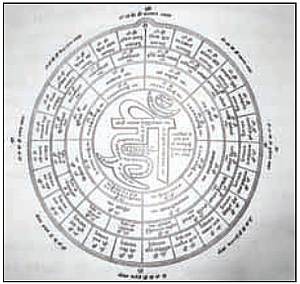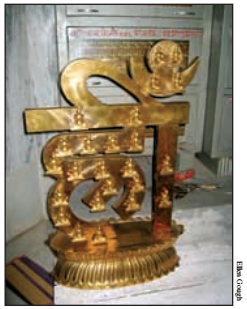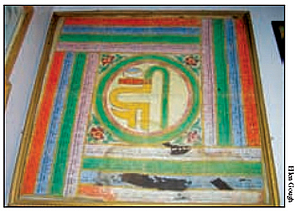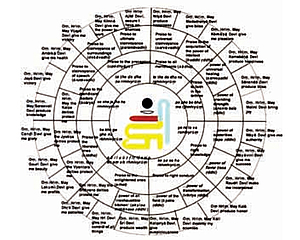
Centre of Jaina Studies Newsletter: SOAS - University of London
In recent decades, scholars have produced a bulk of studies on the formation and ritual use of the mantras and yantras of Hinduism and Buddhism. However, save a few mentions, academics have largely overlooked their Jain equivalents, with researchers consistently viewing these practices in Jainism as a borrowing from Hinduism. The common scholarly consent is summed up well by André Padoux's (1989: 295) claim that "Jain mantraśāstra, in fact, does not differ in its essentials from the Hindu version and is not very developed". At one level, the first half of this statement is true. If the 'essentials' of mantraśāstra are the use of mantras, the structure of a maṇḍala, and the significance of certain syllables, colours, etc., then yes, Hindu and Jain mantraśāstra are very similar. If, however, the 'essentials' of mantraśāstra are the particular mantras used, the specific symbols of a maṇḍala, and how these images are worshiped, then Jain and Hindu mantraśāstra at times differ considerably.
My MA dissertation at SOAS, "Jain Tantra, Mantra, and the Ṛṣimaṇḍala Yantra", examines the history, philosophy, and ritual use of Jain yantras, with particular regard to the Digambara Ṛṣimaṇḍala Yantra, in order to refute this notion that Jain yantras are underdeveloped. Building on John Cort's (2002) criticism of this overused 'Jains stole it from the Hindus' formula, my study illustrates how the Ṛṣimaṇḍala Yantra is not simply a 'Hindu' diagram hung in Jain temples, but instead contains key components of classical Jain cosmology, epistemology, and the path to liberation. It also underlines three tentative defining characteristics of Jain yantras in general: 1) the use of the Pañcanamaskāra Mantra and Prakrit, 2) the focus on mantras rather than images, and 3) Representations of the seed syllable (bīja mantra) 'arhaṃ.' While there is no room here to discuss the third feature, the following overview of the history and components of the Ṛṣimaṇḍala Yantra will highlight the first two of these characteristics.
The Pañcanamaskāra Mantra, the set of Prakrit praises to the five supreme divinities of Jainism (pañcaparameṣṭhī), is the keystone of Jain mantraśāstra, and the five supreme beings it honours are at heart of the most well known Jain yantras. The Ṛṣimaṇḍala Yantra seems to have emerged in the medieval period amongst a variety of elaborate diagrams whose nuclei depict an arhat (enlightened being) surrounded by different homages to the remaining pañca-parameṣṭhīs. The seed syllable 'hrīṃ' in the centre of the Ṛṣimaṇḍala Yantra is said to encapsulate all of the 24 tīrthaṅkaras. Each arhat, endowed with his own colour, resides in a particular location in the 'hrīṃ.' The second ring from the inside then contains a Sanskrit version of the Pañcanamaskāra Mantra along with praises to the three jewels (tri-ratna) of right faith (samyag-darśana), right knowledge (samyag-jñāna), and right conduct (samyak-cāritra). While we cannot be certain, medieval descriptions of diagrams with similar components (see Shah 1955/1998: 99) suggest that the Ṛṣimaṇḍala Yantra was first used in ritual around the 13th century. The earliest known extant example of this maṇḍala, a Śvetāmbara version, reliably dates to 1515 (Sastri 1938:429).

Digambara Ṛṣimaṇḍala in Śāstrī n.d.:170.
The Ṛṣimaṇḍala Yantra is common to both Śvetāmbaras and Digambaras, with only a few differences between the sects' versions, such as the placement of the 22nd tīrthaṅkara Mallinātha within the hrīṃ at the centre of the maṇḍala. Śvetāmbaras, believing Malli to be a woman, place her in the blue 'ī' of the hrīṃ, which Sastri (1938: 427) notes represents śakti, or the feminine creative power. The Digambaras, believing Malli to be male, distance themselves from this interpretation by locating Malli in the golden 'hr' with fifteen other tīrthaṅkaras. My dissertation, while highlighting differences such as this one, focuses on the Digambara version of the diagram as it is used by Bīsapanthī Digambaras in North India, particularly in Delhi and Hastinapur. I spent the summers of 2007 and 2008 studying the Ṛṣimaṇḍala in and around these two cities with various Digambara lay and ascetic practitioners, including the highly influential Digambara nun Āryikā Jñānamatī Mātā jī. Jñānamatī Mātā (1981/2004) has written a popular Hindi ritual manual on the Ṛṣimaṇḍala entitled Ṛṣimaṇḍal Pūjā Vidhān.
In addition to the Ṛṣimaṇḍal Pūjā Vidhān, my discussion of the components and ritual use of the diagram also relies upon a medieval Digambara text, the Ṛṣimaṇḍala Stotra (the Śvetāmbara version differs in only a few verses). The Ṛṣimaṇḍala Stotra is a Sanskrit hymn of praise that outlines the diagram's components and the benefits of worshiping them. Its recitation is also included in the worship (pūjā) of the diagram, which is usually performed to acquire worldly benefits. The group Ṛṣimaṇḍala Pūjā, performed in Sanskrit by ritual experts, is a day-long event that can be stretched out over eight days. Ritual specialists (pratiṣṭhācārya) perform it a few times a year, only if a patron pays for its performance.
While these group pūjās are elaborate occasions when ritual specialists place various fruits, flowers, etc. onto a large cloth Ṛṣimaṇḍala Yantra established temporarily in the temple, Jñānamatī Mātā's Ṛṣimaṇḍal Pūjā Vidhān, the manual on which I focus in the dissertation, is a more intimate affair wherein practitioners individually offer the substances of the Digambara eightfold pūjā to a small metal yantra by transferring the substances from one plate (thālī) to another. The outset of the Ṛṣimaṇḍal Vidhān describes the formation of the Ṛṣimaṇḍala Yantra, which is essentially formed of mantras that the Ṛṣimaṇḍala Stotra outlines, without any images. This highlights the second defining characteristic of Jain yantras outlined above, the use of mantras rather than images in these diagrams. As one of the few scholars to study Jain yantras, S. Andhare, has noted, "Mantras... become an integral part of [Jain] yantras in a way that is rare in Buddhist or Hindu mandalas..."(Andhare 1994: 81). In the case of the Ṛṣimaṇḍala, this focus on words rather than depictions of deities allowed Jain ācāryas to link this diagram directly to Jain scriptural teachings. We can see this by looking at the components of the diagram.
The Ṛṣimaṇḍala Yantra follows the generic template of maṇḍalas of all Indic traditions, in that its concentric rings depict a gradual shift from placating everyday distresses through the worship of lower deities at the periphery of the diagram, to contemplating higher concerns beyond this earthly realm at the nucleus of the image. In the case of the Ṛṣimaṇḍala Yantra, this progression from the outer rings to centre of the maṇḍala can represent a gradual purification of the soul. Each ring, listed here from the outermost ring to the centre, relates to a textual description of an increasingly purified soul:

Image showing the placement of the tīrthaṅkaras in the 'hrīṃ' of the Digambara Ṛṣimaṇḍala. Commisioned by Jñānamatī Mātā for the Dhyāna Mandira in the Jambūdvīpa Complex, Hastinapur. June 2008.

Ṛṣimaṇḍala in a Śvetāmbara temple, Jaipur. June 2007.
- 10 digpālas (guardians of the directions)
- 24 goddesses
- 4 types of gods
bhāvana (mansion-dwelling)
vyantara (forest)
jyotiṣa (luminous)
vyaimānika/kalpa (empyrean) - 8 types of supernatural powers (ṛddhi)
buddhi ṛddhi (intellect)
sarvoṣadhi ṛddhi (universal healing)
ananta bala ṛddhi (unending strength)
tapa ṛddhi (austerities)
rasa ṛddhi (flavor)
vikriya ṛddhi (transformation)
kṣetra ṛddhi (field)
akṣīṇa mahānasa ṛddhi ('inexhaustable
kitchen') - 4 types of avadhis (clairvoyant knowledge) for
spiritually advanced mendicants
śrutāvadhi (scriptural knowledge)
deśāvadhi (knowledge of surroundings)
paramāvadhi (supreme knowledge)
sarvāvadhi (universal knowledge) - 3 jewels (ratnatraya)faith (darśana) in the
tattvas, right knowledge (jñāna), right
conduct (cāritra) - 5 parameṣṭhīs: arhat (enlightened being),
siddha (liberated being), upādhyāya (mendicant teacher),
ācārya (mendicant leader),
sādhu (mendicant) - 8 vārgas (Devanāgarī alphabet)symbolizing
the teachings of the Jinas - 3 parts of hrīṃ
- The form (bimba) of the arhat
- 24 tīrthaṅkaras
(Jain 2006:263; Jñānamatī 1984/2004:6-8)
We can see here how the diagram encapsulates classical Jain cosmology, epistemology, and the path to liberation, as these components come straight from classical Jain sources. The descriptions of the lifespans, houses, vehicles, etc. of the four types of gods listed above, for example, can be found in the fourth chapter of Umāsvāti's Tattvārtha Sūtra, while the types of clairvoyant knowledge (avadhi) are described in that text's first chapter. The standard list of the eight supernatural powers (ṛddhi) can be found in the Digambara 5th-or-6th-century text Tiloyapaṇṇatti by Yativṛṣabha (Flügel 2008). Tiloyapaṇṇatti's list of these eight categories conforms exactly to the list given in the Ṛṣimaṇḍala Stotra, except it has the power of action (kriyā) instead of the power of the 'inexhaustible kitchen' (akṣīṇa mahānasa ṛddhi). The Tiloyapaṇṇatti, rather than listing akṣīṇa mahānasa ṛddhi as one of the eight categories of ṛddhis, defines it as one of the two attributes of the eighth ṛddhi category, the power of the field (kṣetra ṛddhi). Thus, rather than an underdeveloped copy of a Hindu yantra, the Ṛṣimaṇḍala Yantra is instead a sophisticated encapsulation of the most important teachings of classical Jain scriptures. I hope my dissertation, by discrediting the idea that Jain yantras are 'underdeveloped', will invite further studies of the many uniquely Jain yantras.

Translation by Ellen Gough of the Digambara Ṛṣimaṇḍala, as described in Jñānamatī (1984/2004:6-8). The names of the digpālas are not uniform for every Ṛṣimaṇḍala, and thus have been omitted.
Ellen Gough MA, SOAS Department of the Study of Religions, now at Yale, was holder of the 2007 Jain Spirit Fellowship in Jaina Studies at SOAS. Her work on the Ṛṣimaṇḍala Yantra was awarded the IOJ sponsored Centre of Jaina Studies Dissertation Prize 2008.
References:
Andhare, Shridhar. "Jain Monumental Painting." The Peaceful Liberators: Jain Art from India. Ed. P. Pratapaditya. 77-83. New York: Thames & Hudson, 1995.
Cort, John E. "Bhakti in the Early Jain Tradition: Un derstanding Devotional Religion in South Asia." History of Religions 42 (2002) 59-86.
Flügel, Peter Jaina Rituals of Death. London:Routledge, (forthcoming).
Jñānamatī Mātā, Āryikā. Ṛṣimaṇḍala Pūjā Vidhāna. Hastināpur: Digambara Jaina Triloka Śodha Saṃsthāna, 1981. (Reprint 2004).
Padoux, André "Mantras-What Are They?" Mantra. G Ed. H. P. Alper. 295-318. Albany: State University of New York Press, 1989.
Ṛṣimaṇḍala Pūjā Bhāṣā. In Pūjana-Pāṭha-Pradīpa. Ed. Śrīkṛṣṇa Jain. 263-272. New Delhi: Śailī Śrī Pārśvanātha Digambara Saṃsthāna, 2006.
Śāstrī, Dharmacandra. Mantra Mahā Vijñāna. Ghaziabad: Ācārya Dharmaśuta Granthmālā, n.d.
Sastri, Hiranand. "A pre-Mughal Citrapaṭa from Gujarat." The Indian Historical Quarterly 14 (1938), 425-31.
Shah, Umakant Premanand. Studies in Jaina Art. Banaras: Jaina Cultural Research Society, 1955. (Reprint Varanasi: Parsvanatha Vidyapitha 1998).
Tattvārtha-Sūtra of Umāsvāti/Umāsvāmi. Translated by Nathmal Tatia as That Which Is. New York: Harper Collins, 1994.
 Dr. Ellen Gough
Dr. Ellen Gough